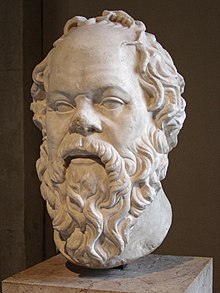Siete tratados
Siete tratados (in English: Seven Treatises) is a collection of essays published by the Ecuadorian writer Juan Montalvo in two volumes, in 1882 and 1883, respectively.
For the most part, it was written between 1873 and 1875, while its author was outlawed in Ipiales,[1] since, during that period, Gabriel García Moreno, his enemy who was known for repressing any attempt at opposition, governed Ecuador.
[2] The novel is written with such an abundance of historical quotations, parables, and examples, that reading it is not easy: the reader may lose interest in the work because of the author's waste of erudition and his digressions, which are not always accurate.
[4] He takes Montesquieu and his study on the climatological influence on the development of the distinctive features of races as a reference, although he does not agree with his criterion that all racial differences are caused, simply, by changes in climate.
[2] In book number 1 of his magazine El Cosmopolita [es], Montalvo, commenting on his first visit to Rome, made references to the ancient history of the city, presenting it as a model of morality and virtue.
Socialism, by a mysterious enchainment of ideas and things, has its cradle in despotism, who would believe it; and it could not, by the law of nature, have been born in a people that adored liberty, cultivated it and enjoyed it as its greatest, truest and most present good.
[2] He ends the treatise by saying:I could honor myself in silence with respect to the charge, as gratuitous as it is reckless, of affirming that I am an enemy of Jesus Christ, I who cannot hear his name without a delicate and virtuous shudder of spirit, which transports me as if by magic to the time and life of that heavenly man.
He then explains that something similar happens with the word “genio”: “The entelechy of the ancients has today one as heir of the vast, high, deep, unknown and mysterious: this is the 'genio'”.
"Ingenio" is judicious, often timid: its flight does not translimate the space of an apocate sensibility: "genio" is agitated in a kind of celestial dementia, it flaps its wings impetuously and, with its eyes on fire, it shoots up.
Montalvo is concerned with giving brilliance to two aspects: the merit of the brave men who fought with courage to see their homelands free, and the importance of a broad and disinterested liberty.
[3] For Professor Antonio Sacoto [es], it is the least successful of the treatises both aesthetically and for its content, while noting that it looks like an attempt to analyze Plato's Dialogues.
El buscapié, which later served as a prologue for the aforementioned novel, aims to explain that, by imitating Cervantes, he does not intend to equal or compete with him, but simply to offer him a tribute.
[1] In November of the same year, the government of Venezuela granted Montalvo the fifth class decoration of the Bust of the Liberator, for having highly distinguished himself in literature.
[1] A Central American country (possibly El Salvador)[5] even requested 400 copies to be distributed among all its libraries as a model of good reading.
[1] The transitory economic success moved the writer so much that he sent fabrics and clothes to his family, as well as a grand piano to Eloy Alfaro's sister.
In a pastoral letter, he described the work as a “brood of vipers in a basket of flowers”, with which its author “bends the knee before our adorable redeemer, but it is to give him sacrilegious slaps in his divine face.”[1] Some thinkers did not agree with his opinion, as in the case of Francisco García Calderón, who wrote:For three years now, only Sir Juan Montalvo has managed to completely excite me; and I see that my enthusiasm was well-founded, since his illustriousness of Quito has condemned the book, giving the world a sample of his very clear lights, of his pilgrim wit, of his sapiensa sum.


